Note: The content of the hyperlinked webpages not necessarily represent my point of view, they're here for informational purposes.
The area of today's Budapest was already populated in ancient days: the caves of the Buda hills were home to cavemen, and archeological findings from the 19th century B.C. suggest the existence of a larger settlement here. The vicinity was then ruled by the romans between the 1st and 4th century A.D. The seat of their province Pannonium-inferior was called Aquincum - located where now Óbuda (today's 3rd district) is. The first hungarian nomad tribes arrived around 880. After they've settled in 896, Aquincum was chosen as the headquarters of the tribal state. The turn of the 10th and 11th century marks the baptization of the hungarians, and also the establishment of the hungarian state as a european-style monarchy. Although overshadowed by the religious importance of Esztergom and Székesfehérvár, Óbuda was still one of the seats of the king. Buda was then inhabited by ploughmen and royal servants, while Pest became a merchant-city dominated by german patricians.
Genghis Khan's tartar hordes destroyed nearly every sign of life around here in 1241. After they retreated, the cities were strengthened, this is when they have first started to build the Buda Castle (I wrote "first" because the castle you see today is not the first one, as it was rebuilt, partially destroyed, then rebuilt again during our history). The twin cities of Buda and Pest flourished again in the 15th century during the reign of King Mathias Corvinus. Sadly, the halcyon days ended with the turkish occupation which lasted from 1541 to 1686. This "150 years of turkish subjection" (as we call it) trailed - besides a number of things - the culture of public baths, which still lasts. After the ottoman army was beaten, Buda was taken by germans, austrians, bavarians, serbs, spaniards, while hungarians were banned from the castle district. The next few hundred years were overshadowed by the Habsburg domination, in which Hungary was one of the provinces of the Austrian Empire. It was the first half of the 19th century in which the call for freedom became louder and louder. This peaked in a revolution and war of indepence in 1948-49, which was beaten down.
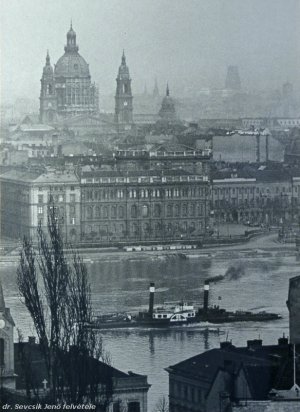 Nevertheless,
the hungarians' desire for autonomy was harder and harder to coerce after
the defeat, and this resulted in the Accord of 1867, which marked the birth
of the Austro-Hungarian
Monarchy. A glorious area began: most of Pest's classicist and
baroque architecture has vanished to give way to art
nouveau, eclectism, wide boulevards and swell bridges. On the 1st of
January, 1873 Buda, Pest and Óbuda was united into
Budapest.
Although the twin cities were already referred to as "Budapest" earlier,
Budapest as one city is quite new in contrast to the long historic past
of its constituents. In those years, the imperial city of Vienna was trying
to outdo Paris in terms of elegance, while Budapest was trying to outdo
Vienna. Noble palaces, theaters like the Opera
House, elegant
cafes and monuments like Heroes'
Square or the Fishermen's
Bastion emerged. In the 1870's they started to build out the telephone
network, and our first
tramline in 1887 was among the first ones in Europe.
Nevertheless,
the hungarians' desire for autonomy was harder and harder to coerce after
the defeat, and this resulted in the Accord of 1867, which marked the birth
of the Austro-Hungarian
Monarchy. A glorious area began: most of Pest's classicist and
baroque architecture has vanished to give way to art
nouveau, eclectism, wide boulevards and swell bridges. On the 1st of
January, 1873 Buda, Pest and Óbuda was united into
Budapest.
Although the twin cities were already referred to as "Budapest" earlier,
Budapest as one city is quite new in contrast to the long historic past
of its constituents. In those years, the imperial city of Vienna was trying
to outdo Paris in terms of elegance, while Budapest was trying to outdo
Vienna. Noble palaces, theaters like the Opera
House, elegant
cafes and monuments like Heroes'
Square or the Fishermen's
Bastion emerged. In the 1870's they started to build out the telephone
network, and our first
tramline in 1887 was among the first ones in Europe.
The whole city was built as the capital of a large kingdom, just like the wonderful House of Parliament, which might seem a bit too large for a 10-million-people country like today's Hungary. That's because the country has lost 2/3rd (!) of its territory due to the Trianon Peace Treaty after the 1st World War. The country and the city could hardly recover from this shock by the time World War 2 broke out. It had even more desastrous impact on Budapest: first, the bombardment by the USAF and RAF after the german occupation in 1944, then the siege of the city by the Red Army. A little-known fact, but the siege of Budapest lasted more than three months - for comparison: Vienna was taken in six days, and Berlin in just two weeks! You can imagine the impact, for example all Danube-bridges were blown up by retreating german troops.
 The
next few years were dominated by the growing communist influence, which
led to secularization of (most) private companies in 1848, and the
comunists gaining full power in 1949. This was a
stalinist-type dictatorship, oppressing, mistrustful, and violently
centralizing. "Greater Budapest" was born under such circumstances, when
many ambient settlements were annexed by the capital in 1950.
The
next few years were dominated by the growing communist influence, which
led to secularization of (most) private companies in 1848, and the
comunists gaining full power in 1949. This was a
stalinist-type dictatorship, oppressing, mistrustful, and violently
centralizing. "Greater Budapest" was born under such circumstances, when
many ambient settlements were annexed by the capital in 1950.
After the beaten revolution in 1956 came a so-called "soft dictatorship", which coined a couple of labels like "the happiest shed in the communist camp" or "pottage communism". Although the communist system fell in 1989, the face of the city still bears the characteristic marks of its last 50 years, like the large high-rise housing estates at the outskirts, but also two subway lines which still determine the layout of the public transportation network.
This might be just my personal opinion, but nothing very notable has happenned since then. Of course a few remaining bomb-sites were built in, and we came to learn "plazas" (large shopping malls), but the structure of the city remained the same. I think the city and its people are still searching for the right direction to go to...
[The
"official" Budapest Website on the history of the city]
[A
more extensive history page]
![]()
Budapest is located on the two sides of the river Danube: Buda is a more residential area with hills, while the center of Pest is surrounded by industrial facilities, that are mostly unused now, hence its name "Rust Belt". Once-separate settlements like Óbuda or Újpest can no more be told apart, because the amoeba-like expansion of Budapest into "Greater Budapest" has washed away most obvious signs of the city limits. Of course expertised eyes can recognise artifical barriers like railway lines, but the current partitioning into disctricts can hardly be understood just by looking at the streets. Another barrier: the Danube is quite a wide river, so the differences between Buda and Pest are still harsh, e.g. despite that Budapest is usually referred to as "Pest" in the countryside, inhabitants of Buda think of themselves as "Buda-ers" and not "Budapesters", let alone not "Pest-ers" :-)
The Danube (or as we call itt: Duna) also gives Budapest a very characteristic look. Dominating the panorama on one side are the Buda hills, especially Gellért-hegy (St. Gellert's Hill) and the Várhegy (Castle Hill). The other side is a wide-streching metropolis with old houses, church towers and city parks. Connecting the two cities are bridges, and not just like any bridges, but masterpieces of architecture! There are also a few islands between the river banks: Margit-sziget (Margarite island) and Hajógyári-sziget (Shipyard island) are green parks, while Csepel-sziget (Csepel island) is a residential and industrial area.
[Map
of Budapest 1]
[Map
of Budapest 2]
![]()
History of Budapest public transportation - in a nutshell
History of the tram in Budapest
The first horse tram service in Budapest was launched in 1866 on the Kálvin tér-Újpest route, which is still one of the most heavily used traffic paths, only that we now have a subway ("metro" as we call it) instead of the trams on the surface. After the success of the first horse tram line new routes were launched in great numbers, but there was one great problem: Buda and Pest were still two seperate cities, so they've had two companies operating two separate networks: BKVT in Buda, and PKVT in Pest. There was no connection between the networks in the beginning. The twin cities have united in 1873 and similariliy did the companies, although only a few years later. The new company's name was the old one: BKVT. (If you're wondering why I'm tiring you with this: the name of the old companies will occur on these pages several times!)
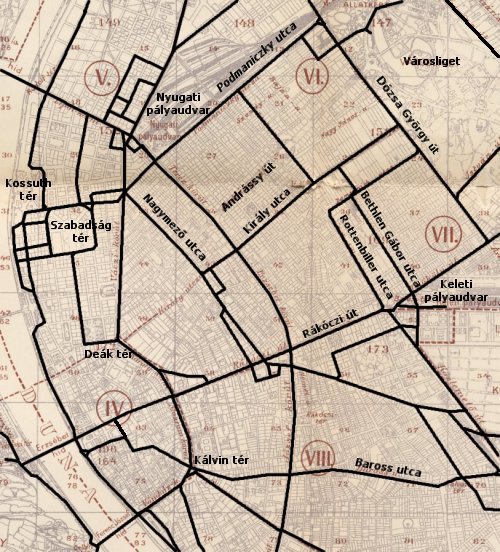 In
1887 a new star was born: in November, a narrow-gauge electric tram service
was launched on the Grand Boulevard between the Nyugati railway
station and Király utca. It was a pilot project designed and
financed by Siemens et Halske, who have just invented the tram a few years
ago. The trains used an under-surface current collector that was specifically
designed for Budapest. The line was a big success, so Siemens has founded
a new public transportation company called BVV, which became BVVV a few
years later, when Siemens (the company) sold its interests. In 1889, the
continent's first normal-gauge inner city tram service was launched, and
soon the old horse tram company BKVT began to electrificate it's own routes
to keep up. This decision marked the start of a race between BKVT and BVVV:
the companies were struggling to overdo each other at all costs. On the
map to the right you can see all streets and places in the inner city of
Pest where trams ran between 1914 and 1981 - quite a dense network, I would
say (of course not by US scale) - and most of this was built by these two
companies until 1923, when they were united!
In
1887 a new star was born: in November, a narrow-gauge electric tram service
was launched on the Grand Boulevard between the Nyugati railway
station and Király utca. It was a pilot project designed and
financed by Siemens et Halske, who have just invented the tram a few years
ago. The trains used an under-surface current collector that was specifically
designed for Budapest. The line was a big success, so Siemens has founded
a new public transportation company called BVV, which became BVVV a few
years later, when Siemens (the company) sold its interests. In 1889, the
continent's first normal-gauge inner city tram service was launched, and
soon the old horse tram company BKVT began to electrificate it's own routes
to keep up. This decision marked the start of a race between BKVT and BVVV:
the companies were struggling to overdo each other at all costs. On the
map to the right you can see all streets and places in the inner city of
Pest where trams ran between 1914 and 1981 - quite a dense network, I would
say (of course not by US scale) - and most of this was built by these two
companies until 1923, when they were united!
After World War 1
things looked pretty bad. Only a fragment of the public transport system
was still usable, and after two consecutive political revolutions, the
shareholders of BKVT and BVVV refused to take back their companies. Thus
a new company called BSzKRt (spell "bhaz-cart") was formed in 1923. In
the first few years rolling stock, rail and electric systems were unified
and/or rebuilt, but right after that they also began to experiment.  "Experimenting"
meant evaluating new techniques (twin-set coupling, auxiliary-power multiple
units, articulated cars) and restructuring the whole public transport system
of Budapest. Beside other things this also meant that most of the tram
routes in the narrow streets of the inner city were closed, and new, more
effective soltutions were chosen instead. The city's bus services have
also slowly started to became more and more important, yet their greatest
days were still to came.
"Experimenting"
meant evaluating new techniques (twin-set coupling, auxiliary-power multiple
units, articulated cars) and restructuring the whole public transport system
of Budapest. Beside other things this also meant that most of the tram
routes in the narrow streets of the inner city were closed, and new, more
effective soltutions were chosen instead. The city's bus services have
also slowly started to became more and more important, yet their greatest
days were still to came.
After the second World War, things looked even more catastrophic: massive loss of human life, all bridges over the river Danube were destroyed, and there was no eletricity. Yet, the first tram route in Pest was re-started while there were still bitter fights going on in Buda! In 1950 a new company was formed in full state ownership and municipal control: FVV (for "Capital Tramway Company"). This company was only responsible for the trams and trolleybuses, but not for buses, suburban railways that were now operated by the companies FAÜ, BHÉV/FHÉV/MÁV-BEV. FVV have done a pretty good job: old vehicles (many of which were made well before World War 1) were renovated/rebodied, and new types were introduced, among others the famous "UV class", which is still a symbol for Budapest trams. Much of what's still in use (including infrastructure and rolling stock) was bought or built in this era. Of course there were also unpleasant changes: the tram network was simplified - some of the "classic" routes have dissappeared.
 In
1968 all public transportation operators (trams, trolleybuses, buses, light
rail commuter trains, the Széchenyi hegy rack railway, ferryboats,
and after 1972 the subway, too) were merged into one company: BKV. In the
following years trams were neglected, while articulated buses and the relaunched
subway programme have became the official way to go. By this time, most
of the tram rolling stock was terrifyingly old (manufactured between 1896
and 1939), and the construction works for the underground overloaded both
the city and BKV financially, so there was no possibility for other big
developements like buying large series of modern trams or launching new
routes. In connection with the substitution of tram routes with the subway
we can call this the "demise" of the Budapest tram network.
In
1968 all public transportation operators (trams, trolleybuses, buses, light
rail commuter trains, the Széchenyi hegy rack railway, ferryboats,
and after 1972 the subway, too) were merged into one company: BKV. In the
following years trams were neglected, while articulated buses and the relaunched
subway programme have became the official way to go. By this time, most
of the tram rolling stock was terrifyingly old (manufactured between 1896
and 1939), and the construction works for the underground overloaded both
the city and BKV financially, so there was no possibility for other big
developements like buying large series of modern trams or launching new
routes. In connection with the substitution of tram routes with the subway
we can call this the "demise" of the Budapest tram network.
 After
the "Iron Curtain" has dissappeared, and Hungary became a free country
(again), came a wave of economical miseries: there was hardly enough money
for keeping the remnants of the tram network in working order, let alone
for any new developments. Tram routes were closed, and lines with low utilisation
(mainly route 12, 17, 30 and 52) are still "endangered". Most of these
services are badly in need of a track renewal, but this fails to happen
due to lack of funds and sometimes even lack of will to maintain the service
in the long run. At the same time progression is slow, and priorities are
often declared by politicians, so what's in the fore gets renewed: the
Milleneum Subway Line (M1) was renovated, the tracks of Grand Boulevard
routes 4 and 6 were rebuilt, but then the same worn-off cars would continue
to use the new tracks.
After
the "Iron Curtain" has dissappeared, and Hungary became a free country
(again), came a wave of economical miseries: there was hardly enough money
for keeping the remnants of the tram network in working order, let alone
for any new developments. Tram routes were closed, and lines with low utilisation
(mainly route 12, 17, 30 and 52) are still "endangered". Most of these
services are badly in need of a track renewal, but this fails to happen
due to lack of funds and sometimes even lack of will to maintain the service
in the long run. At the same time progression is slow, and priorities are
often declared by politicians, so what's in the fore gets renewed: the
Milleneum Subway Line (M1) was renovated, the tracks of Grand Boulevard
routes 4 and 6 were rebuilt, but then the same worn-off cars would continue
to use the new tracks.
Of course it would be unfair to call the evolving of the Budapest tram network a mere run-down, because there are many planned and realised extensions. For example, route 14 was extended by 1800 meters in 1998, just like route 1 - which now circles Pest - was by more than 6.5 kilometers since 1990. With a few hundred meters of track-laying, route 63 and 13 was connected, resulting in an outer ring route 3 (route 47 and 49 runs on the inner Small Boulevard (Kiskörút), route 4 and 6 on the Grand Boulevard, route 1 on the Hungária Ring). A bunch of tram routes (56, 59, 61) were upgraded into value-added "BKV Plusz" services (now decommisioned), others received rebuilt sections with new - mostly reserved - tracks and stops (Bartók Béla út, Fehérvári út, Haller utca), and in 2004 we even expect a few hundred meters extension of route 18 on brand new tracks!
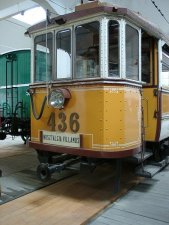 At
the end of the 19th century hungarian trams looked very much like all the
trams around the world, but then a disctinct "hungarian" look started to
appear, which was most dominant on the front of the cars. One of the most
typical examples, a vintage BVVV streetcar can be seen to the left. This
design features a front windshield divided into three parts with sharp
corners and with the middle one beeing small and openable, narrow steps
up to the open platform, where the tram driver stands, and sinkable side
windows.
At
the end of the 19th century hungarian trams looked very much like all the
trams around the world, but then a disctinct "hungarian" look started to
appear, which was most dominant on the front of the cars. One of the most
typical examples, a vintage BVVV streetcar can be seen to the left. This
design features a front windshield divided into three parts with sharp
corners and with the middle one beeing small and openable, narrow steps
up to the open platform, where the tram driver stands, and sinkable side
windows.
The most important manufacturers of the heydays were Schlick-Nicholson and Ganz. Earlier the electric parts were bought from Siemens or General Electric Union and the transport companies installed them into the chassis' themselves, but then even that duty was taken over by Ganz. By the 30's the company has became the ultimate tram manufacturer in Hungary, and it kept that position until the late 70's.
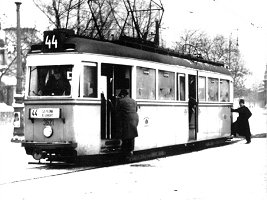 One
of their most ambitious designs was the 3600-series
(see picture to the right), also called "Stuka" after the german dive bomber
aircraft (the sound of the vehicle was very similar). This was a simple,
but fast, comfortable and relatively low-floor streetcar, designed in 1939
midst pre-war conditions, when the governement has commited itself for
supporting other transportation means than cars. Later they expanded the
idea of this streetcar to build long multiple sets: the new train set was
introduced in 1948, but due to technical difficulties the idea of producing
it in great quantities was dismissed. A few years later the need for new
trams with a greater capacity was even greater, so Ganz designed the UV-class,
which was the most dominant vehicle in the Budapest tram system until
the mid-90's.
One
of their most ambitious designs was the 3600-series
(see picture to the right), also called "Stuka" after the german dive bomber
aircraft (the sound of the vehicle was very similar). This was a simple,
but fast, comfortable and relatively low-floor streetcar, designed in 1939
midst pre-war conditions, when the governement has commited itself for
supporting other transportation means than cars. Later they expanded the
idea of this streetcar to build long multiple sets: the new train set was
introduced in 1948, but due to technical difficulties the idea of producing
it in great quantities was dismissed. A few years later the need for new
trams with a greater capacity was even greater, so Ganz designed the UV-class,
which was the most dominant vehicle in the Budapest tram system until
the mid-90's. 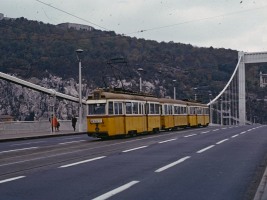 Optically
these new cars were very much like the old Stukas, but the electrical system
and the bogies were totally different. 375 cars were built until 1965,
when Ganz introduced its 8-axle
articulated tram. Although this latter design was less reliable, they
still play an important role in the city's life.
Optically
these new cars were very much like the old Stukas, but the electrical system
and the bogies were totally different. 375 cars were built until 1965,
when Ganz introduced its 8-axle
articulated tram. Although this latter design was less reliable, they
still play an important role in the city's life.
Between 1980 and 84 BKV have bought 322 4-axle Tatra T5C5 cars. These were the first non-hungarian trams in Budapest in almost hundred years! They were purposed as a temporary replacement for ancient 2-axle cars, but the financial situation of the country was so bad at the time that the idea of purchasing more modern trams was dismissed. Of course this led to the demise of some really interesting tram routes, too! Later there experiments for extending the life-span and increasing the comfort of old cars, but the KCSV7 series (Ganz articulated cars with new interior and chopper control system instead of contactors) with 3O vehicles can hardly be seen as a big thing with a rolling stock numbering around 7OO cars, while the 2O modernised UV tramcars (dubbed MUV) only got a small dosis of cosmetic surgery instead of real modernisation. The purchase of 92 used DÜWAG Stadtbahn cars from Hannover has secured the existence of a few outer-rim services, but without high platform stops and reserved high-speed right-of-way, many of their assets are left unused.
The latest gem of the Budapest tram system is the Combino Plus (or Combino Supra), the longest tramcar of the world. Of course the arrival of the forty 100% low-floor cars has inducted big changes: the Combinos replaced the Ganz articulated cars on the Grand Boulevard, and in turn these Ganz artics replaced the UVs everywhere.
The future of the Budapest tram
It's not easy to tell the future. Current plans to give the proposed M4 metro line a higher priority could draw away funds from the tram, which is already under-financed. The arrival of the new 54-meter-long low-floor Siemens trams for the Grand Boulevard routes in 2OO6 was certainly a good opportunity for celebration, but it also could be seen as a sign that only a handful of the busiest lines will be kept and upgraded, while the rest is sentenced to demise. We'll see what happens, but until that, let's hope politicians realise the unused possibilities of the Budapest tram network!
![]()
Population: 1.8 million, from that 54%
women
Territory: 525 km2, divided
into 23 disctricts, 13.4% forest, 2.3% park
Highest point: János-hegy, 529 m
Modal split (public transportation/car/afoot):
59/29/12
in %
Tram + cogwheel railway (2002)
Network length: 155 km
Total length of tracks: 349 km
Total length of lines: 229 km
Total number of vehicles: 792
Average number of vehicles in traffic
on a working day: 544
Commercial speed: 13.4 km/h
Number of stops: 679
Total number of passengers carried in
a year: 370 million
HÉV lines (2002)
Network length: 102 km
Total length of tracks: 239 km
Total number of vehicles: 294
Average number of vehicles in traffic
on a working day: 228
Commercial speed: 22.4 km/h
Number of stops: 139
Total number of passengers carried in
a year: 63 million
Subway (2002)
Network length: 35 km
Total length of tracks: 92 km
Total length of lines: 31 km
Total number of vehicles: 403
Average number of vehicles in traffic
on a working day: 284
Commercial speed: 23.9 km/h
Number of stops: 78
Total number of passengers carried in
a year: 317 million
Trolleybus (2002)
Network length: 66 km
Total length of lines: 65 km
Total number of vehicles: 165
Average number of vehicles in traffic
on a working day: 123
Commercial speed: 11.8 km/h
Number of stops: 278
Total number of passengers carried in
a year: 82 million
Bus (2002)
Network length: 763 km
Total length of lines:1313 km
Total number of vehicles: 1397
Average number of vehicles in traffic
on a working day: 1108
Commercial speed: 16.5 km/h
Number of stops: 3519
Total number of passengers carried in
a year: 575 million
[The
official website of the Budapest City Hall]
[The
official website of the BKV]
Back to the
top
Back
to the index
Disclaimer: The author cannot
be held responsible for mistakes, misinterpretations, inaccuracies, inactualities,
etc. on/of these pages, nor for the content of other pages linked in.
![]()
Send
a mail to the author
The
author's homepage